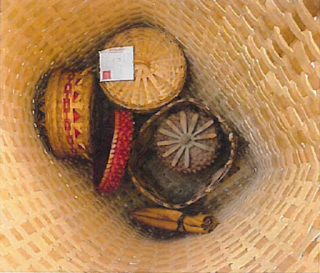Pokagon Potawatomi Black Ash Baskets: Our Storytellers opens to the public April 16, 2021 in the Maran Gallery near the Maori House.
In the last century, items of Native material culture have become items for non-Native collections, museums, and exhibitions-although they were often poorly labeled, identified, and understood. However, particularly since the 1990s, Native peoples have demanded a voice and authority in sharing the beauty, technology, and meaning of their art and artifacts. One of the powers in these objects includes the ability to facilitate conversations between peoples of different communities and backgrounds. The Field Museum has been an important example of the new way in which Natives and non-Natives collaborate on exhibitions about Indigenous cultures. This spring the Field Museum will open Pokagon Potawatomi Black Ash Baskets: Our Storytellers to further strengthen the transition to shared storytelling.
The Pokagon Potawatomi peoples are familiar with the traditions of our ancestors and know the multiplicity of stories within baskets. The baskets-assumed silent, static, and lifeless-speak to many of us. We have ears that will listen. We know the origins. The baskets are imbued with the spirit of the material and maker. We hear the stories that the basket waits to tell. A thank you prayer, spoken softly, a song sung to the basket as busy hands work the ash. Hands that lay down tobacco, weave strips into another life; scrape ribbons of wood until they are as smooth as satin. Listen for the voices that sing children to sleep, comfort a partner, worry over an elder, and pray. The hands heard weaving are the same hands that make bread and plant seeds for food. Seeds of knowledge and wisdom are also planted with these busy hands. Stories emanate from the baskets. Like the songs, prayers, and plantings of our grandmothers, we hear those stories. Because we know to listen. We know the songs the baskets sing.
This exhibition celebrates these baskets and their makers. It tells a story of survival and resilience. But it also contains a cautionary tale and a warning of environmental catastrophe as the emerald ash borer, an invasive beetle from Asia, decimates black ash populations in North America. What will the Pokagon Potawatomi make their iconic baskets out of if all the black ash trees are gone? That is a question that concerns us all.
-Dr. John N. Low, Pokagon Band of Potawatomi Co-Curator and Basket Caretaker.
- Field Museum
- "New exhibit featuring Pokagon Potawatomi basket making to open at the Field Museum"
- Dr. John N. Low, LinkedIn, April 5, 2021.
- Bodéwadmi Wisgat Gokpenagen | The Black Ash Baskets of the Pokagon Band of Potawatomi Indians Opening
- February 13, 2020.
- Celebrate Indigenous Peoples' Day at Ohio State Newark!
- October 9, 2019.


No comments:
Post a Comment